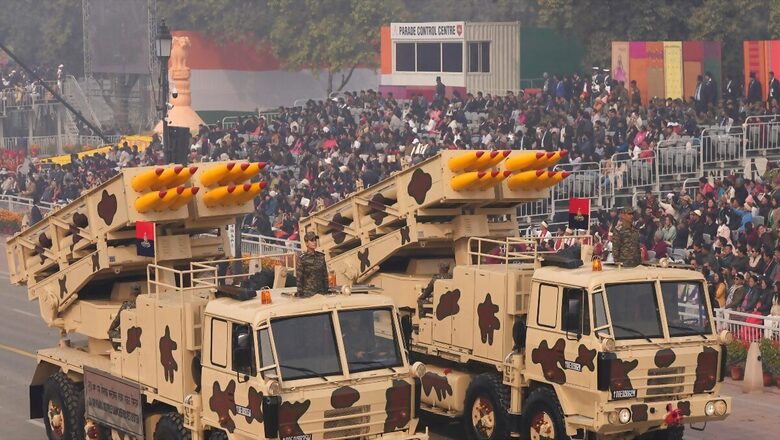
views
India is today the world’s fastest growing major economy, and the strides it is taking in expanding its economic output are gaining global admiration. In the next five years, it will become the world’s third largest economy. More importantly, though, it is critical for a country with soaring ambitions to have a defence-industrial complex that can meet not just domestic needs, but also emerge as a global player by supplying weapon systems to a host of other countries.
Bharat has emerged as just that, and its defence exports grew 32.5 per cent in the last fiscal, crossing the Rs 21,000-crore mark. In 2022-23, India’s defence exports stood at Rs 15,920 crore. The ascendance is, therefore, hard to miss and reflects what a country of India’s size and scale can achieve when it puts its mind to a goal, cuts down on unnecessary red-tapism and sets higher ambitions. Particularly remarkable has been the synergy seen between the private and public sectors in defence manufacturing, both of which contributed 60 per cent and 40 per cent, respectively, to total exports in 2023-24.
The right intent and an unhindered focus on delivery of goals can prove to be a crucial factor in ensuring that policymaking has the desired impact. Perhaps this is why total defence exports between 2004-05 and 2013-14 stood only at Rs 4,312 crore, while in the last 10 years, they have gone up to Rs 88,319 crore – a staggering 21 times rise. Simultaneously, defence imports have witnessed a drop in light of the country’s spirited push for self-reliance, or aatmanirbharta.
Record defence exports: What does it mean?
Beyond mere numbers, one must understand what India’s record defence exports mean. For starters, India is fast emerging as a big player in the global security arena. This also means that it can play the role of an equaliser in a global environment fraught with decades-old hegemonies.
India now shares the stage with countries that not just make weapons for their own use but also export them to like-minded nations around the world. At present, India is exporting weapons and military equipment to 85 countries, facilitated by approximately 100 companies engaged in this trade. The exports encompass a range of items such as missiles, artillery, rockets, armoured vehicles, offshore patrol vessels, protective gear, radar systems, surveillance equipment and ammunition.
It remains to be seen whether India achieves its stated goal of exporting military equipment worth Rs 35,000 crore in the current fiscal. Having said that, we now know for a fact that the country’s defence exports are growing by leaps and bounds.
Global community torn by Ukraine, Gaza conflicts
This also comes at a crucial time for the global community, which is being torn apart by two full-blown conflicts – one in Europe and the other in West Asia. Russia’s ability to supply weapons to other countries has been severely curtailed due to the war in Ukraine. In better times, Moscow had carved a lucrative market for itself in Africa, Asia and the wider Indo-Pacific.
India has itself been a major recipient of Russian weapons and equipment. But, that is fast changing. According to the Stockholm International Peace Research Institute (SIPRI), India’s arms imports from Russia have declined drastically, from 76 per cent in 2009-13 to 36 per cent in 2019-23. Effectively, this is the first time that less than half of India’s arms imports come from Russia.
A vacuum appears to have emerged in global markets, and India is stepping in to fill the void. While Russia’s war in Ukraine has limited its ability to export weapons, the US and the broader coalition of its western partners find their own defence production lines stretched to the limit. The wars in Ukraine and Gaza have already taken a heavy toll on America’s inventories. This is among the leading causes why Ukraine is no longer being supplied with the weapons it needs to fight Russia.
READ MORE: Opinion | India in Indo-Pacific: The Emergence of a Vocal, More Assertive Bulwark Against China
Israel, another major military exporter, finds itself bogged down by the war in Gaza. This is a war with no foreseeable end in sight, and the situation in the Gulf could very well get much worse before it starts getting better. Therefore, Israel cannot be expected to export weapons at a scale it used to before.
China, meanwhile, is gaining international disrepute for being an expansionist entity that has ulterior and nefarious motives in all its global transactions, especially those that are strategic in nature. Pakistan alone accounts for 61 per cent of China’s arms exports, and that is quite a revealing statistic. In fact, 78 per cent of all of China’s arms exports go to just three countries – Pakistan, Bangladesh and Thailand.
India’s window of opportunity
It is not surprising that in such a scenario, India sees a window of opportunity for itself. India supplies weapons and equipment to a diverse basket of countries, including Italy, the Maldives, Russia, Sri Lanka, the UAE, the Philippines, Saudi Arabia, Poland, Egypt, Israel, Spain and Chile. The US, UK and France are buying defence electronics from India, while Mauritius, Seychelles and the Maldives have procured fast interceptor boats.
READ MORE: Straight Talk | Bharat Has Arrived: Indian Navy’s Daring Operations Are a Message to the World
Defence ministry data shows India supplies bulletproof jackets to 34 countries, including Australia, Japan, Israel and Brazil. About 10 countries, including the UAE, Egypt, Indonesia and Thailand purchase ammunition from India. The world’s interest in advanced Indian weapon systems is growing as well. It is not just the Philippines that is set to buy India’s BrahMos supersonic cruise missiles. Countries like Vietnam and Indonesia are also keen to clinch deals with New Delhi for these powerful missiles. State-owned Hindustan Aeronautics Limited (HAL), meanwhile, is in talks with six countries to export the indigenous light combat aircraft, Tejas. These include Argentina, the Philippines, Botswana, Egypt and Nigeria.
Defence push in the Global South
India’s defence push among countries of the Global South is hard to miss. The geopolitical climate is ripe for India to tap into this emerging market, and that is what New Delhi is doing. The Global South knows better than to put all its eggs in one basket.
There is a global consensus now that any country that either outsources its defence or depends disproportionately on military imports from one or two sources stands at a natural disadvantage. This becomes most pronounced during times of conflict, as traditional players who dominate the arms market tend to attach a litany of terms and conditions on weapons sales.
Therefore, India’s emergence as a defence exporter can provide much relief to countries in the Global South. India is seen by many as a natural ally, one which does not attach unnecessary strings to military deals. Coupled with the Indian Navy’s proactive operations in the Arabian Sea and Gulf of Aden, it does not take a genius to figure out that Bharat is fast emerging as a major player in the global security realm. And this, by the way, is just the beginning.
Views expressed in the above piece are personal and solely that of the author. They do not necessarily reflect News18’s views.


















Comments
0 comment